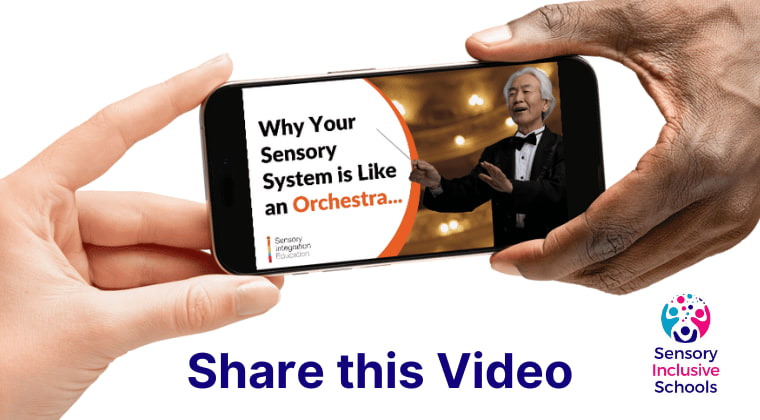
As educators, you know the classroom is filled with unique individuals, each with their own way of learning and engaging with the world. But did you know that every single student—and staff member—also has their own unique sensory system? This system plays a critical role in how we all move, focus, learn, and interact with others. Understanding this can be a game-changer, not just for the few but for everyone.
We’re excited to share a new short video from Sensory Integration Education that explains sensory processing in a simple, relatable way. It uses a beautiful analogy—comparing our sensory systems to an orchestra where the brain is the conductor, coordinating how all the different instruments (senses) work together. This is a concept that resonates with both adults and children, helping to make sense of the invisible ways sensory information impacts daily life.
Here’s why sharing this video with both staff and parents is so important:
1. We All Have a Sensory System
Sensory processing is not something limited to certain students with specific needs. It affects everyone! Just like an orchestra needs a conductor to stay in tune, we all rely on our brain to help us manage sensory input—whether that’s the brightness of classroom lights, the noise levels during lunchtime, or even how comfortable our clothes feel during PE. Everyone’s brain has moments where it might struggle to keep the orchestra playing smoothly, and when it does, simple tasks can feel overwhelming.
2. Creating Sensory-Friendly Spaces Helps Everyone
When we understand more about how sensory processing works, we become better equipped to create environments that support learning for all students. Whether that’s through adjusting lighting, reducing noise levels, or being mindful of how certain activities might overwhelm some students, a sensory-friendly classroom benefits everyone. By watching this video, school staff and parents can start to appreciate that sensory needs aren’t just a special requirement for a few students but are part of the human experience.
3. Supporting Students’ Unique Sensory Systems
Some students might experience more challenges with their sensory systems than others. For these students, sensory input can be too much or too little, making it harder to focus, coordinate movements, or even communicate. The video does a great job of showing how these differences are natural and common—and how simple changes in the environment can make a world of difference for them.
4. Building Understanding Between Staff, Parents, and Students
By sharing this video, we can create a shared understanding between school staff and parents about how sensory processing impacts daily life. This helps build a more cohesive, supportive environment for students, allowing parents and teachers to work together in creating the best learning spaces for all.

What Can You Do?
We encourage you to share this video widely with staff, parents, and anyone involved in the care and education of children. It’s a simple, accessible introduction to sensory processing that can open up important conversations about how we can make our schools more inclusive for every sensory system.
Let’s spread the word about sensory processing and build environments that support all learners. Share the video, start the conversation, and help create a sensory-inclusive school!


